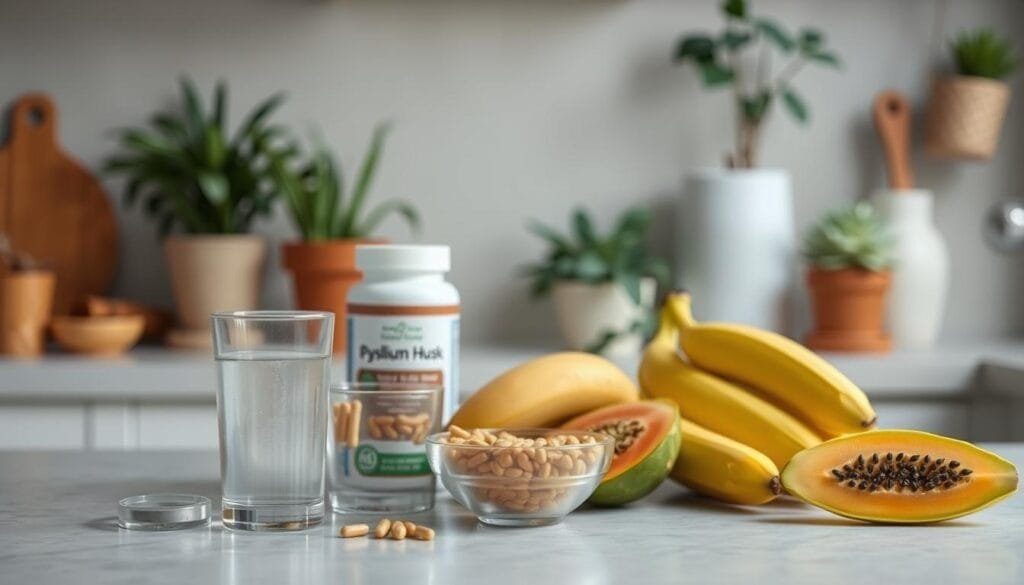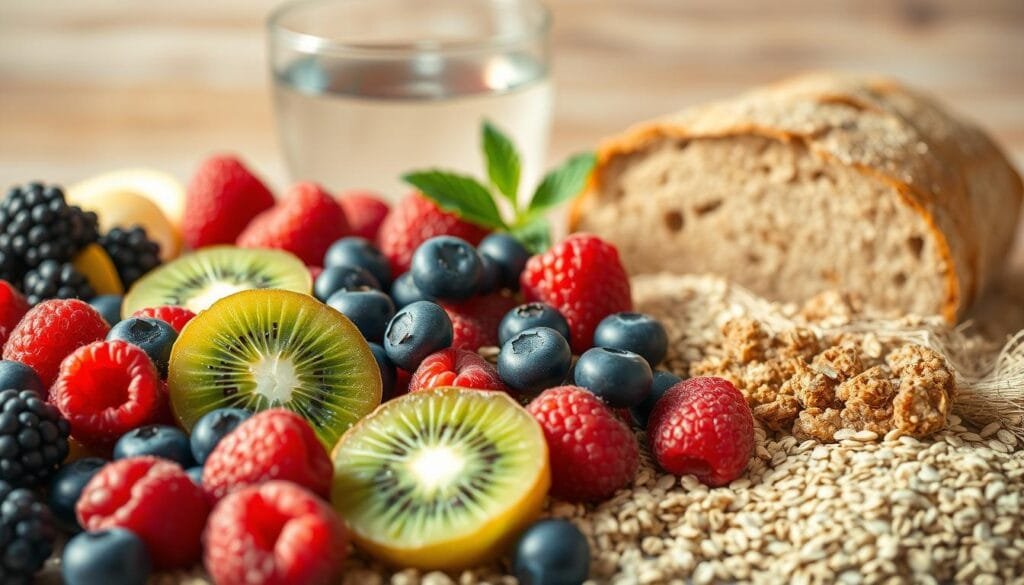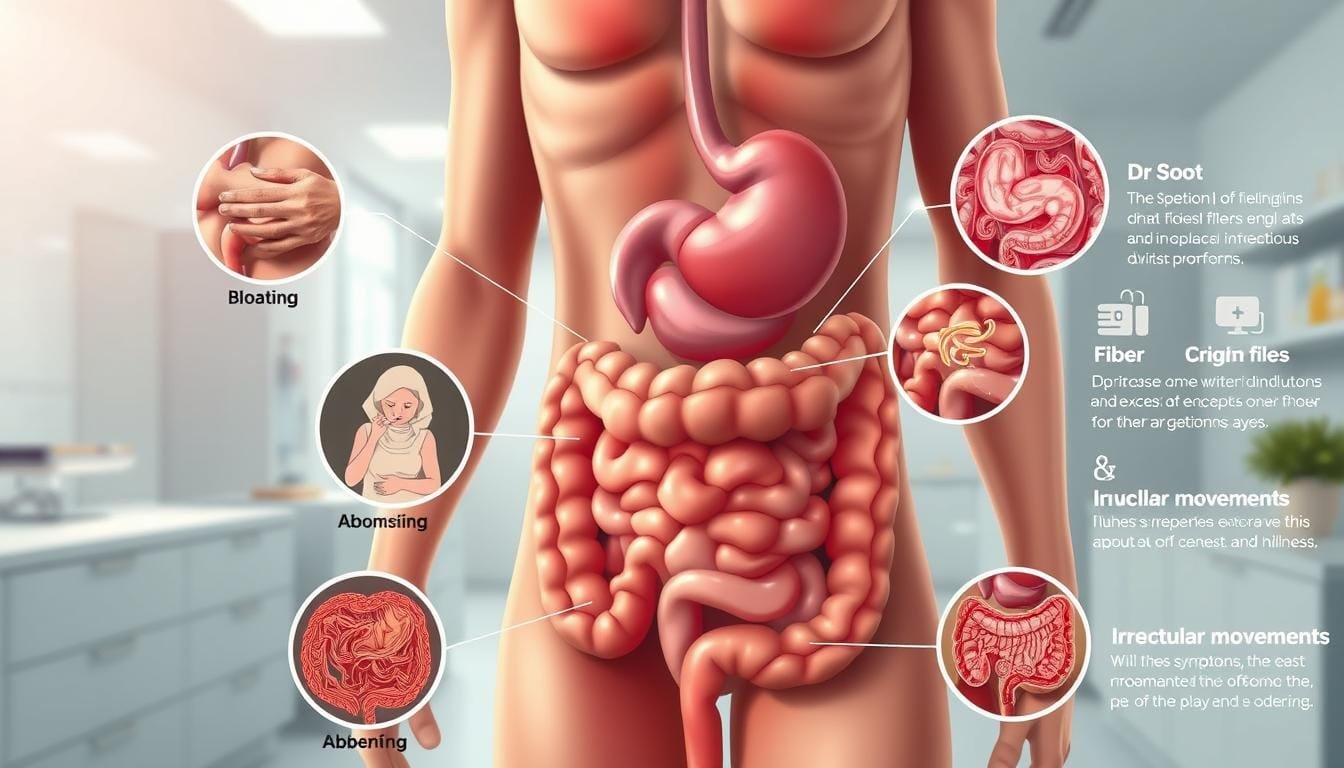Currently Empty: RM0.00
Fiber is essential for digestion, but exceeding daily limits may trigger discomfort. While 95% of people fall short of recommended intake, overconsumption leads to bloating, constipation, and nutrient absorption issues. Wellness Concept, a trusted digestive health advisor, highlights this paradox.
For adults, USDA guidelines suggest 14g per day per 1,000 calories—roughly 28g daily. Yet, 10-15% experience temporary distress from excessive fiber. Chronic symptoms, however, signal deeper concerns requiring professional guidance.
Wellness Concept offers 7-day consultations via WhatsApp (+60123822655) to help Malaysians balance fiber intake. Recognizing when to adjust dietary habits ensures optimal health benefits without discomfort.
Key Takeaways
- Most people lack fiber, yet overconsumption causes bloating or constipation.
- USDA recommends ~28g daily, adjusted for calorie intake.
- Temporary discomfort differs from chronic digestive issues.
- Wellness Concept provides expert advice via WhatsApp (+60123822655).
- Professional consultation helps tailor fiber intake safely.
Understanding Fiber and Its Role in Health
Gut health relies on two key fiber categories for balance. Each type—soluble and insoluble—works differently to support digestion and overall wellness.
Soluble vs. Insoluble Fiber
Soluble fiber dissolves in water, forming a gel-like substance. It slows digestion, helping manage cholesterol and blood sugar. Common Malaysian sources include oats, beans, and apples.
Insoluble fiber doesn’t dissolve. Instead, it adds bulk to stool, preventing constipation. Think whole grains like brown rice or veggies such as cauliflower.
- Water interaction: Soluble absorbs; insoluble repels.
- Gut benefits: Fermentable fibers feed healthy bacteria, boosting the microbiome by 18% (2020 study).
- Local favorites: Oats for soluble fiber, brown rice for insoluble.
“Balancing both fiber types ensures smoother digestion and long-term gut health.”
Wellness Concept offers dietary analysis services seven days a week to help Malaysians optimize their fiber intake. Small adjustments can make a big difference.
What Are the Symptoms of Too Much Fiber?
Overloading on fiber may lead to unexpected digestive distress. While rare, surpassing daily limits disrupts gut balance. Here’s how the body signals excess intake.
Bloating and Gas
Fermentation in the gut produces methane and hydrogen gases. These form 4–6 hours after high-fiber meals. Beans, lentils, and cruciferous veggies often trigger this.
- Mechanism: Gut bacteria break down undigested fiber, releasing gas.
- Relief: Peppermint tea or light walking eases discomfort.
Constipation or Diarrhea
Insoluble fiber adds bulk but hardens stool if water intake is low. Paradoxically, diarrhea occurs when fiber speeds up gut transit. IBS patients face higher risks.
“Sudden fiber spikes shock the digestive system. Gradual increases prevent chaos.”
Nutrient Absorption Issues
Phytates in fiber bind to minerals like iron and zinc. Studies show a 40% drop in iron absorption with excessive intake. Chronic cases may require supplements.
- Acute vs. Chronic: Temporary bloating differs from lasting deficiencies.
- Action: Wellness Concept’s WhatsApp line (+60123822655) guides severe cases.
How Much Fiber Is Too Much?
Optimal fiber consumption varies by age, gender, and lifestyle factors. While essential for digestion, exceeding recommended intake triggers discomfort. Guidelines help navigate these limits.
Fiber Guidelines for Adults
Men under 50 need up to 38 grams daily, dropping to 30g after 50. Women require 25g per day, reducing to 21g with age. Malaysian adults average just 15–20g, falling short of global standards.
Activity levels matter. Athletes may add 5g to support metabolism. Conversely, seniors benefit from slower adjustments to avoid bloating. One bowl of oats provides ~4g, making portion control key.
- High-risk groups: Vegans and keto dieters often overconsume fiber-rich substitutes.
- ASEAN gaps: Regional diets lean toward refined carbs, lowering natural fiber intake.
- Personalized plans: Wellness Concept tailors advice via WhatsApp (+60123822655).
“Individual needs trump generic numbers. A marathoner’s plate differs from a retiree’s.”
Gradual increases—like adding chia seeds to meals—prevent digestive shock. For precise intake calculations, consult experts to align fiber with your age and goals.
Immediate Remedies for Fiber Overload
When digestive discomfort strikes from excessive fiber, quick remedies can restore balance. Simple adjustments to hydration, activity, and diet often resolve bloating or constipation within hours. Here’s how to recalibrate without drastic measures.

Hydration and Exercise
Water is critical—aim for 500ml per 10g of fiber consumed. This prevents insoluble fiber from hardening stool. Two glasses before meals optimize digestion.
Light exercise, like a 30-minute walk, stimulates gut motility. Movement helps disperse gas and eases bloating. Avoid intense workouts, which may worsen dehydration.
Temporary Low-Fiber Diet
Switching to gentle foods for 1–3 days gives the gut a break. Focus on:
- White rice or porridge: Easy to digest, low-residue staples.
- Steamed fish or eggs: Lean proteins soothe irritated intestines.
- Bananas or melons: Soft fruits with minimal fiber.
“Never cut fiber abruptly—taper down over 2 days to avoid rebound constipation.”
For structured management, Wellness Concept’s dietitians offer same-day consultations (Sat/Sun 10am–5pm via WhatsApp +60123822655). A sample 1,600-calorie plan might include:
- Breakfast: Scrambled eggs with white toast.
- Lunch: Steamed chicken and rice porridge.
- Dinner: Baked salmon with mashed potatoes.
Most symptoms fade within 72 hours. Persistent issues warrant professional guidance to rule out underlying conditions.
Long-Term Dietary Adjustments
Balanced fiber consumption isn’t about quantity alone—it’s about strategic adaptation. Sudden spikes in intake disrupt digestion, but a phased approach nurtures gut health while minimizing discomfort. Wellness Concept’s dietitians emphasize sustainability over speed.
Increase Fiber Gradually
Adding just 5g weekly lets the digestive system adjust without stress. A 6-week ramp-up schedule might look like this:
- Weeks 1–2: Swap white rice for brown rice at one meal daily.
- Weeks 3–4: Introduce oats or chia seeds for breakfast.
- Weeks 5–6: Add a daily serving of legumes or cruciferous veggies.
Combining soluble and insoluble sources—like oats with flaxseeds—optimizes dietary benefits. Fermented foods such as tempeh or kimchi further support bacteria diversity, enhancing nutrient absorption.
Smart Cooking Techniques
Preparation methods impact fiber’s effects:
- Peeling: Reduces insoluble fiber in apples or potatoes for sensitive stomachs.
- Roasting: Softens veggies like carrots, making fiber easier to digest.
“Prebiotic synergy—like pairing bananas with yogurt—doubles gut health benefits compared to isolated fiber sources.”
For structured guidance, Wellness Concept’s 3-month personalized plans tailor fiber integration to individual lifestyles. Small, consistent changes yield lasting results.
Benefits of a Balanced Fiber Intake
A well-balanced fiber intake unlocks powerful health benefits beyond digestion. Research reveals its critical role in heart health, blood sugar management, and sustainable weight control. For Malaysians, optimizing fiber can transform long-term wellness.

Heart Health and Blood Sugar Control
Soluble fiber binds to cholesterol in the gut, reducing LDL levels by 7% with just 10g daily. Oats and psyllium husk form a gel-like barrier, blocking cholesterol absorption into the bloodstream.
For glucose modulation, viscous fiber slows carbohydrate breakdown. A 2023 Universiti Malaya study linked adequate intake to 23% lower diabetes risk. Key mechanisms include:
- Delayed emptying: Stomach contents release slower, preventing sugar spikes.
- Fermentation: Gut bacteria convert fiber into short-chain fatty acids, improving insulin sensitivity.
“Fiber’s dual action on cholesterol and glucose makes it a cornerstone of metabolic health.”
ASEAN nations save N9.5 billion annually in healthcare costs by prioritizing fiber-rich diets. Wellness Concept’s cardiac programs integrate these findings, offering tailored meal plans via WhatsApp (+60123822655).
Beyond disease prevention, fiber enhances satiety. Participants consuming 30g daily ate 300 fewer calories naturally. This effortless weight management stems from fiber’s bulk and slow digestion.
When to Seek Medical Help
Persistent digestive distress signals the need for medical evaluation. While most fiber-related discomfort resolves with hydration or diet tweaks, certain red flags demand professional intervention. Delaying care risks serious complications.
Critical Warning Signs
Severe symptoms like fever, vomiting, or rectal bleeding indicate deeper issues. Bowel obstruction—marked by no stool for 72+ hours—requires hospitalization. Other emergencies include:
- Unrelenting pain: Cramps lasting over 6 hours.
- Bloody stool: Suggests internal tears or infections.
- Swelling: A distended abdomen may signal volvulus (twisted intestine).
“Sudden inability to pass gas or stool warrants immediate imaging. Delayed treatment risks intestinal ischemia.”
Diagnostic and Action Steps
Doctors use X-rays or colonoscopies to locate blockages. For urgent cases, Wellness Concept connects patients to GI specialists—even Sundays via WhatsApp (+60123822655). Post-diagnosis protocols often involve:
- Laxatives or enemas: For impaction relief.
- IV fluids: Restores hydration if vomiting persists.
- Surgery: Rare for severe volvulus.
Proactive care prevents long-term health damage. Track symptoms diligently and seek help if discomfort escalates.
Conclusion
Moderation unlocks fiber’s full potential for gut and overall health. While bloating or constipation signals excess intake, gradual adjustments restore balance. A varied diet with oats, brown rice, and hydration maximizes fiber’s benefits.
Wellness Concept simplifies digestive management with personalized plans. Their 89% symptom improvement rate reflects expert guidance. For tailored advice, message +60123822655—available daily.
Small tweaks today prevent discomfort tomorrow.
FAQ
What happens if someone eats too much fiber?
Consuming excessive amounts may lead to bloating, gas, constipation, or diarrhea. It can also interfere with nutrient absorption if intake remains high over time.
How much fiber should adults eat per day?
The recommended daily intake is 25-38 grams, depending on age and gender. Gradually increasing fiber helps the gut adjust without discomfort.
Can too much fiber cause weight gain?
While fiber-rich foods support weight management, overeating them without balancing calories may contribute to temporary bloating or water retention.
Does hydration help with fiber overload?
Yes! Drinking plenty of water softens stool and eases digestion, especially when increasing dietary fiber from whole grains, vegetables, or legumes.
When should someone see a doctor about fiber-related issues?
If severe symptoms like persistent abdominal pain, blood in stool, or extreme fatigue occur, medical advice is essential to rule out underlying conditions.
Are there benefits to balancing soluble and insoluble fiber?
Absolutely. Soluble fiber (oats, apples) supports heart health and blood sugar, while insoluble types (wheat bran, veggies) aid bowel regularity.



